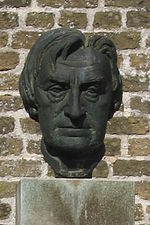- Cyriel Verschaeve
-
Cyriel Verschaeve
Statue in AlveringemBorn 30 April 1874
ArdooieDied 8 November 1949 (aged 75)
Solbad HallOccupation Priest, writer, SS recruitment Spouse None (celibate) Children None (celibate) Cyriel Verschaeve (30 April 1874 – 8 November 1949) was a noted Flemish-nationalist priest and writer who collaborated with the Nazis during the Second World War.
Biography
Born in Ardooie in West Flanders, Belgium to a catholic family, he began training to be a priest at the minor seminary in Roeselare in 1886, before moving on to Bruges in 1892 to complete his studies. He was finally ordained in 1897 and then continued his studies at the Friedrich Schiller University of Jena.
He returned to Belgium in 1911 to become a parish priest at Alveringem. Whilst here he became involved in the pacifist movement after the outbreak of the First World War and was involved in the building of the IJzertoren.
Dismissed as chaplain in 1939, Verschaeve, who had long been sympathetic to Germany, wrote Het Uur van Vlaanderen in 1940 in which he articulated feelings of sympathy amongst the Flemish people for Nazi Germany, especially because of his Romantic admiration for German imperial culture (Richard Wagner). As a result he was appointed to a Nazi set up body to deal with Flemish culture after the occupation of Belgium. He also became involved with recruitment to the Flemish Legion in 1941. Verschaeve was convinced the Soviet Union was the greatest danger to peace and culture in Europe. In 1944 he held a meeting with SS-Reichsführer Heinrich Himmler about the Flemish question, although it achieved little as the Allied advance into Belgium was not far away and Flanders would soon be liberated from Nazi control. Verschaeve told Himmler at this meeting, that while he rejected Nazi paganism, he thought Nazism could become complementary to the salvific message of the Church, as long as it remained political and activist. Until the end of the successful Allied offensive against the Wehrmacht in western Belgium, Verschaeve continued calling upon young Flemish, Catholic, adolescent boys to volunteer in the Waffen-SS foreign legions against Stalin and "Satanic Bolshevism".
He fled to Austria in 1945 and, although condemned to death in absence by a Belgian court, survived there until 1949 when he died of a heart attack at the vicarage of Solbad Hall. He was buried in the Tyrolian town, although in 1973 members of the Vlaamse Militanten Orde dug up his remains and reburied them in Flanders (in Belgium). He remains a celebrated figure amongst the more extreme ends of Flemish nationalism and a symbol of disgraceful Flemish nationalism to French-speaking Catholics.
Apologist historians found Verschaeve to be a Neo-Romantic poet who remained consciously ignorant of Nazi tyranny, to avoid crushing his own beliefs in the superiority of Imperial German 19th century culture, which he saw reflected and defended even by Nazi Germany. They also say his extreme fear of the "roaring Red Russian Lion" (communist Soviet Union), made him give his consent to acts he would have rejected in normal, peaceful circumstances.[citation needed]
Bibliography
Verschaeve wrote extensively on philosophy, adopting a dramatic, poetic writing style. His major works include:
- Jacob van Artevelde (1911)
- Zeesymphonieën (1911)
- Ferdinand Verbiest (1912)
- De schoonheid van het evangelie (1913)
- Passieverhaal (1913)
- Philips van Artevelde (1913)
- Nocturnen (1916–1924)
- Judas (1917)
- Het mysterie (1920)
- Uren bewondering voor groote kunstwerken (1920–1922)
- Maria Magdalena (1928)
- De Kruisboom (1929)
- Elijah (1936)
- Nocturnen (1936)
- Rubens, Vlaanderens Spectrum (1938)
- Jezus (1939)
- Eeuwige gestalten (1944)
Categories:- 1874 births
- 1949 deaths
- Anti-World War I activists
- Belgian Nazi collaborators
- Deaths from myocardial infarction
- Flemish activists
- Flemish priests
- Flemish writers
- Belgian people convicted of war crimes
- Belgian Roman Catholic priests
- Members of the clergy with criminal convictions
- People from West Flanders
Wikimedia Foundation. 2010.

